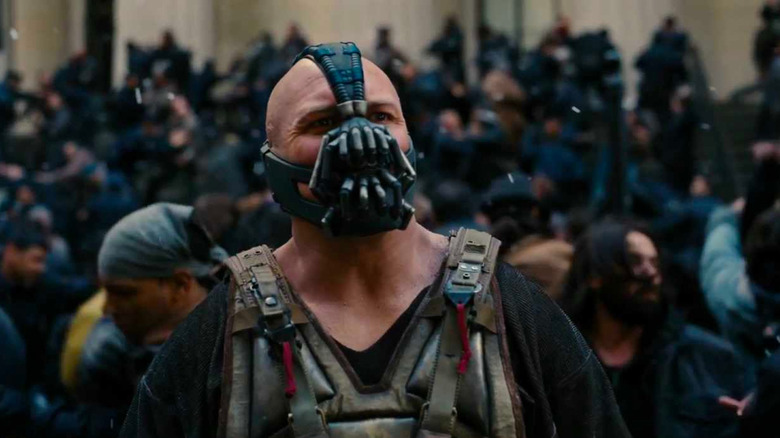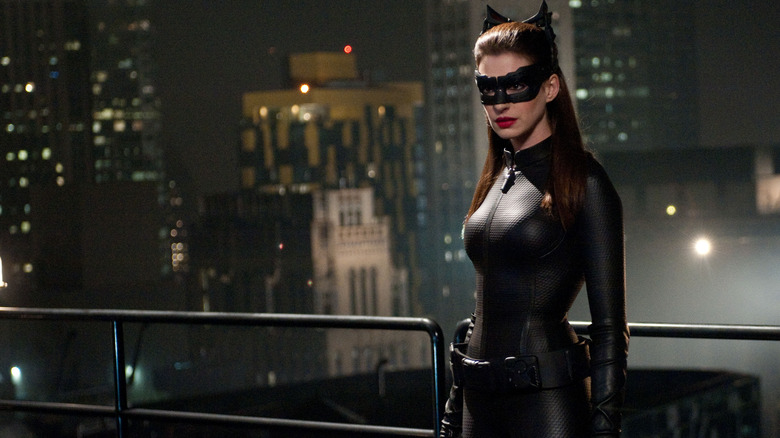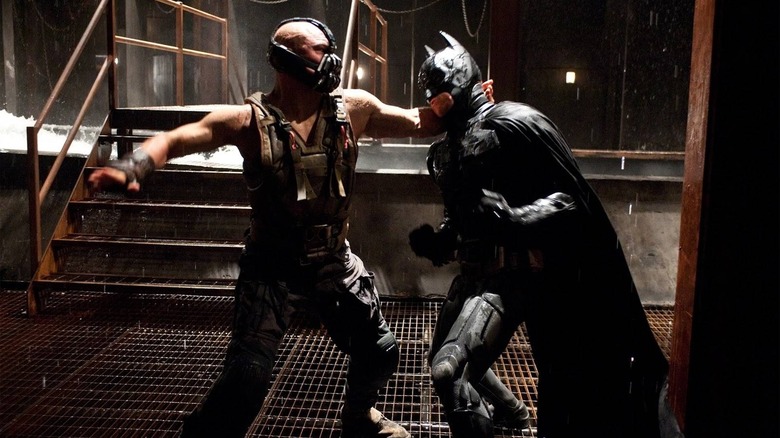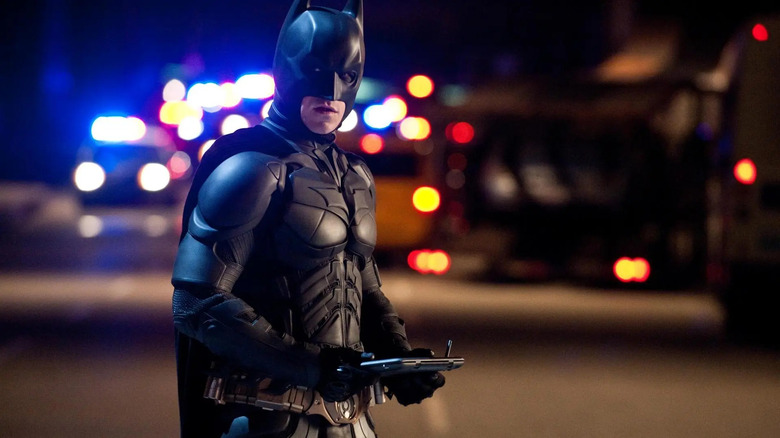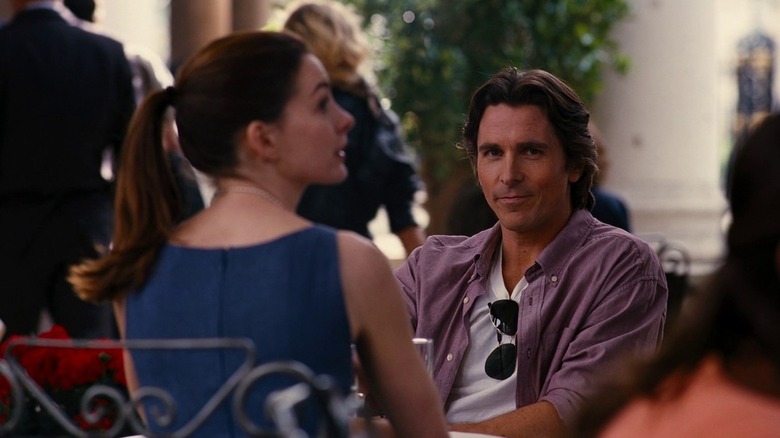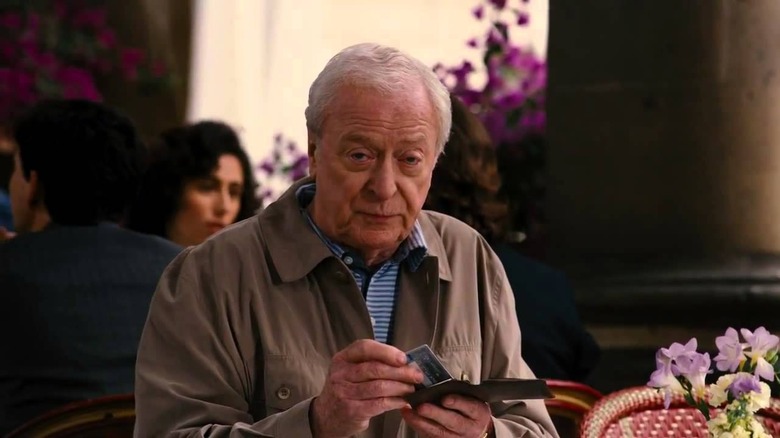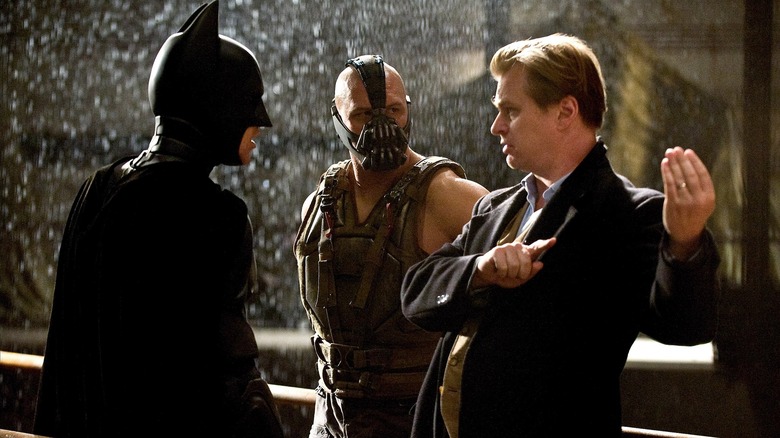The Dark Knight Rises Ending Explained: Batman Ends
After the huge success of "The Dark Knight," the hype for the third entry in Christopher Nolan's trilogy, "The Dark Knight Rises," was massive. And sure enough, the film was a big hit at the box office. But it also left a lot of people cold; it seems folks were hoping for "The Dark Knight 2," and Nolan and company gave them something different. Reviews were mixed, and audience reaction was even harsher. Over the years, the film has been seen as something of a failure. And yet, I maintain "The Dark Knight Rises" is excellent. It's wildly ambitious, even more so than "The Dark Knight," with Nolan channeling the work of Charles Dickens to craft the story of a city under siege.
Let's travel back to the summer of 2012, and break down the film's massive, epic, action-packed finale.
The set-up
In "The Dark Knight Rises," eight years have passed since the events of "The Dark Knight," in which the Joker (Heath Ledger) blew Gotham halfway to hell and turned crusading District Attorney Harvey Dent (Aaron Eckhart) into the murderous Two-Face. In order to keep the people of Gotham hopeful, Batman (Christian Bale) and Gotham Police Commissioner Jim Gordon (Gary Oldman) agreed to cover up Harvey's Two-Face murders. Instead, Batman took the wrap and went into hiding.
Badly injured by his various nights out fighting crime, Batman's alter ego, Bruce Wayne, is also in hiding, stalking around his dark mansion like Charles Foster Kane. But Batman doesn't have the luxury of staying retired for long. Because Bane, a masked mercenary with a goofy voice (played by a hulking Tom Hardy) has come to town with a nuclear device. Bane eventually blows up all the bridges into Gotham and holds the city hostage. He claims he's come to Gotham as a liberator, but of course, we all know that's nonsense. But some of the people of Gotham buy into Bane's message — especially his whole "eat the rich" idea, which is, admittedly, a pretty good plan.
Meanwhile, Batman is tangling with two different women. There's the wealthy Miranda Tate (Marion Cotillard), and then there's cat burglar Selina Kyle, aka Catwoman (Anne Hathaway). Bruce also befriends local cop John Blake (Joseph Gordon-Levitt), who just happens to have correctly deduced that Bruce Wayne is really Batman.
Batman, broken
Because Batman has been out of practice for so long, he ends up being no match for Bane. Bane is a former member of the League of Shadows, the secret ninja group that trained Batman and was run by the nefarious Ra's al Ghul (Liam Neeson). As Batman learns from exposition-ready Alfred (Michael Caine), Bane was locked in an underground prison as a child, and it turned him into the monster he is today — before he was able to escape.
In their first big fight, Bane beats the ever-loving crap out of Batman and breaks his back in the process. Batman/Bruce is shipped off to the same underground prison Alfred mentioned, and feels helpless to save Gotham. Eventually, Bruce heals up and manages to climb his way out of the pit and head back to Gotham (admittedly, the return to Gotham happens off-camera and it's never exactly clear how Bruce/Batman returned, but, whatever — he's rich, so he has connections).
Batman gathers the Gotham cops to stand up to Bane and his goons (the film's prevalence for this type of copaganda is one of its biggest flaws, in my humble opinion). Meanwhile, Bane has taken Miranda Tate hostage. Can Batman save her and Gotham with a little help from Catwoman?
The twist
During the film's big climax, Batman arrives to save Miranda only to find out Miranda is not who she says she is. Instead, she's Ra's al Ghul's daughter Talia, and she wants revenge. We also learn that the child in the pit wasn't Bane — it was Talia, and Bane saved her. They've been working together this entire time. Talia stalks out to blow up Gotham once and for all, and leaves Bane to kill Batman.
Luckily, Catwoman arrives and shoots Bane to death, because she doesn't have Batman's "no kill" rule. This entire twist is unnecessary, and the film would've worked better had it dropped the Talia angle entirely. But Nolan really wanted to bring the trilogy back around to the first film, "Batman Begins," and this is how he did it. Eventually, Talia is killed during a chase and Batman flies the nuclear bomb out over the water — and explodes in the process. Or does he?
Batman ends
One of the biggest things that sets Christopher Nolan's Batman apart from other versions of the character is that Nolan's Batman wants to quit. Right from the first film, Bruce Wayne makes it clear that he doesn't want to be Batman forever. He just wants to clean up his city enough to get things back on track, and then hang up his cape. The Batman of the comics and other movies and TV shows isn't like this at all — he's on a seemingly never-ending mission. But in the Dark Knight Trilogy, Bruce wants nothing more than to get some damn rest and relaxation.
Early in the movie, Alfred tells Bruce a story about the early years when Bruce was off training to be Batman, and presumed dead:
"Every year, I took a holiday. I went to Florence, there's this cafe, on the banks of the Arno. Every fine evening, I'd sit there and order a Fernet Branca. I had this fantasy, that I would look across the tables and I'd see you there, with a wife and maybe a couple of kids. You wouldn't say anything to me, nor me to you. But we'd both know that you'd made it, that you were happy. I never wanted you to come back to Gotham. I always knew there was nothing here for you, except pain and tragedy. And I wanted something more for you than that. I still do."
Sure enough, the final moments of the movie have Alfred returning to that very cafe — and wouldn't ya know it, Bruce Wayne is there (and so is Selina)! Yes, Bruce did not die in the explosion. He merely faked his death to get away from it all, and now Batman is hailed as a hero in Gotham. And while Bruce Wayne's days as Batman might be over, a new Dark Knight is ready to rise. Because Bruce has left info for John Blake on how to access the Batcave. And Blake, whose real name is Robin (get it??) heads to the cave, rising up on a platform before the screen cuts to black. The implication is clear: he will take up the mantle of Batman in some form and continue to keep Gotham safe while Bruce Wayne and Selina live it up in Italy.
It's as conclusive an ending as we can hope for with superhero movies, and Nolan does a great job packing a big, emotional punch. The film's conclusion is so massive that it's downright exhausting, and we can understand why Bruce Wayne has had enough of all this nonsense. I mean, who among us would pass up the chance to run off to Italy with Anne Hathaway?
It was all a dream?
But did the film's ending really happen? Did Alfred really spot Bruce living it up in Florence? Or was that just Alfred fantasizing; daydreaming about what he always wanted to see? Someone asked Christian Bale this very question during a Q&A. "I tend to always say it's what the audience thinks it is," Bale politely states before adding that in his opinion, the scene was not a dream. It really happened. Bruce Wayne really did fake his death and run off to Italy with Selina Kyle, and Alfred really got closure by spotting him in that same cafe where he had always hoped to see Bruce, alive and well and living a new life, free of Gotham and Batman. Again: this is not the ending every Bat-fan probably dreamed of. To some, the idea of Batman giving up his fight against crime is unthinkable. But Nolan's film isn't your traditional take on the Caped Crusader.
Would Nolan return to the world of Batman?
"The Dark Knight Rises" is a pretty conclusive finale; a film that practically yells "THE END!" in your face. And yet, the question lingers: could Nolan return to this world?
"For me, 'The Dark Knight Rises' is specifically and definitely the end of the Batman story as I wanted to tell it, and the open-ended nature of the film is simply a very important thematic idea that we wanted to get into the movie, which is that Batman is a symbol," Nolan said when asked this question, adding: "To me, for [Batman's] mission to succeed, it has to end, so this is the ending for me, and as I say, the open-ended elements are all to do with the thematic idea that Batman was not important as a man, he's more than that. He's a symbol, and the symbol lives on."
In other words, while the legacy of Batman will live on in the world of the film, don't expect Nolan to ever come back and make a fourth "Dark Knight' movie. Nolan wanted the story to have a definitive ending, and it does. Whether you like that ending is another matter.
